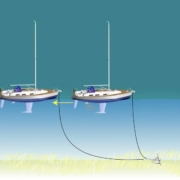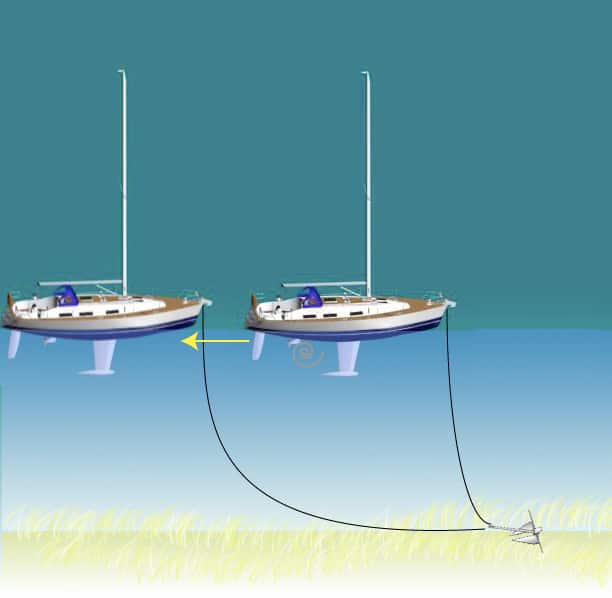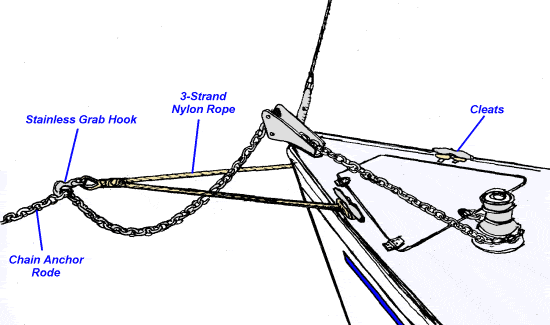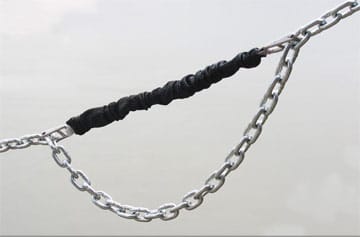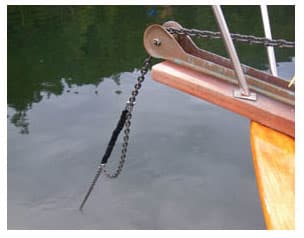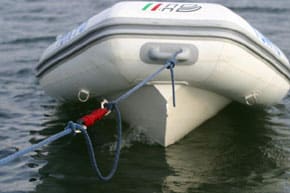Deploying the Anchor
On this page, we will cover:
- Deploying the Anchor
- Setting the Anchor
- Watching the Anchor
Deploying the Anchor
It is important that the person deploying the anchor and the helmsperson are in agreement about the anchoring plan first. Discuss the placement, the direction, the depth, the desired scope, and the setting plan.
Once the boat is in place, it should be facing directly into the wind or upstream if there is a strong current. The boat should not have forward movement.
When pushing the anchor out overboard be careful to not let it swing into the boat and ding the gel coat.
Allow the boat to drift backward slowly or motor back slowly once the anchor is overboard so that the rode lies in a straight line downwind (or downstream) across the bottom from the anchor to the boat.
The bow person deploying the anchor should signal to the helms person when the anchor is overboard and again when it touches the bottom.
The bow person should be noting the amount of rode going overboard to set the correct scope. If this is your boat you should place markers along the rode to indicate length. On most boats, however, you’ll find that the owner or charter company has neglected to do this. In this case, the bow person will need to estimate from the rate of deployment e.g. 1m/s will require 10 seconds to deploy 10m of rode.
When the desired scope is reached the bow person again signals to the helms person that the anchor is ready to be set.
Setting the Anchor
Setting the anchor can be done by simply letting the boat pull back against the anchor as it drifts back with the wind. However, Power Setting is more reliable where the helms person sets the anchor by applying slightly more power to the boat in reverse for approximately 5 seconds to pull downwind against the anchor on the bottom. The action acts to dig the anchor flukes into the bottom.
The bow person can test if the anchor is dragging by putting a finger on the rode. If the anchor is bouncing across the bottom then this vibration will be transmitted up the rode.
Now it is assumed that the anchor is set and the “Is it dragging?” game begins.
The best way to ensure the anchor is set is to dive down upon it. Of course, in many cases diving on the anchor is not practical but if it is – then it is advisable. If you can dive the anchor then ensure that the flukes are turned such that the anchor is digging into the bottom or hooked securely against a big rock.
 |
Most charter boats use all chain as the anchor rode as opposed to most private boats which use rope/chain combination. In the case of all chain, you can use less scope. A scope of 3:1, 4:1 or 5:1 depending on the bottom can suffice. However, use of all-chain anchor line brings up another concern; shock loading to the windlass or bow when the boat is lifted by a wave. This is a major concern when using chain, and calls for the attachment of a line snubber to absorb some of the shock. |
A snubber is a length of nylon line that is connected to the chain anchor rode after the anchor is set. It can be tied on with a rolling hitch, or by attaching a snap hook through an eye spliced in the line, which then attaches to the anchor chain. The snubber is then tied to a cleat. Since the nylon line stretches, it absorbs the shock loading of the chain anchor line. The snubber line should be long enough so that if you want to let out the anchor rode in the middle of the night, then the snubber line can be eased out with the rode at the same time.
Image courtesy of Bosun Supplies, Inc.
Catamarans typically have a snubber line attached to both hulls with a chain hook in the center. The hook is attached to the anchor chain when enough has been let out. Then the windlass is let out some more to allow the line to take the load. This acts in a similar way to the snubber line and takes the load off the windlass while keeping the center of force from the anchor in the center of the two hulls.
A very cool snubber system we have come across is the shockles. These are extremely strong bungee’s with handy clips and hooks on them specially designed for boaty requirements.
Shockle Acts as a Good Snubber
Deployed
They also make a great shock absorber for towing a dinghy but that’s not really an anchoring topic.
Shockles are available by Davis Instruments – see: https://www.davisinstruments.com/collections/power-boating/products/shockles-linesnubber-blue-20-51-cm
Watching the Anchor
Once the anchor is set, a discussion about the scope should take place between the skipper and bow person to ensure the proper amount of rode was deployed.
As discussed previously, the scope is dependent upon wind, length of stay, if you will be leaving the boat, other boats in the harbor, swell, tide, etc. Make a cup of tea or something because this part takes a while. You’ve got to ensure that the anchor is not dragging. It’s a bit difficult because your boat will swing with the wind and so bearing off land will change. So wait until the full extent of a swing then take a bearing by aligning two points on land. Then wait for a couple of swings and compare against the two-point bearing. Then repeat that while you finish your tea.
If anchoring for a longer period of time than just lunch, your bearings will almost invariably change because the wind direction and strength will vary. So you’ll need to take these into account.
The other difficult part is that as light falls your bearings may not be seen, so pick out aligned lights on shore as they come on. Note your compass heading. Now when you get up in the middle of the night to check, if your heading is the same then the bearings to the aligned lights should be the same.
You can also use a hand-bearing compass to check bearings to point on land, but aligning two points is easier.
In summary, the practical part here is much harder than the theory. The boat swings in the wind, the wind direction changes, the wind strength changes and night comes obscuring your original bearings.
A good friend however during all this, is your depth meter. And many depth meters have anchor alarms. You set the anchor alarm to go off when the depth changes by more than 10 ft (3m) or so.
Most GPS units have a drift alarm. You set the alarm for when the boat shifts by a certain distance. Which should be more than the side-to-side swing.

